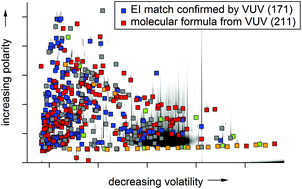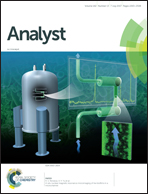Improved molecular level identification of organic compounds using comprehensive two-dimensional chromatography, dual ionization energies and high resolution mass spectrometry†
Abstract
A new analytical methodology combining comprehensive two-dimensional gas chromatography (GC×GC), dual ionization energies and high resolution time of flight mass spectrometry has been developed that improves molecular level identification of organic compounds in complex environmental samples. GC×GC maximizes compound separation providing cleaner mass spectra by minimizing erroneous fragments from interferences and co-eluting peaks. Traditional electron ionization (EI, 70 eV) provides MS fragmentation patterns that can be matched to published EI MS libraries while vacuum ultraviolet photoionization (VUV, 10.5 eV) yields MS with reduced fragmentation enhancing the abundance of the molecular ion providing molecular formulas when combined with high resolution mass spectrometry. We demonstrate this new approach by applying it to a sample of organic aerosol. In this sample, 238 peaks were matched to EI MS library data with FM ≥ 800 but a fifth (42 compounds) were determined to be incorrectly identified because the molecular formula was not confirmed by the VUV MS data. This highlights the importance of using a complementary technique to confirm compound identifications even for peaks with very good matching statistics. In total, 171 compounds were identified by EI MS matching to library spectra with confirmation of the molecular formula from the high resolution VUV MS data and were not dependent on the matching statistics being above a threshold value. A large number of unidentified peaks were still observed with FM < 800, which in routine analysis would typically be neglected. Where possible, these peaks were assigned molecular formulas from the VUV MS data (211 in total). In total, the combination of EI and VUV MS data provides more than twice as much molecular level peak information than traditional approaches and improves confidence in the identification of individual organic compounds. The molecular formula data from the VUV MS data was used, in conjunction with GC×GC retention times and the observed EI MS, to generate a new, searchable EI MS library compatible with the standard NIST MS search program. This library is deliberately dynamic and editable so that other end users can add new entries and update existing entries as new information becomes available.



 Please wait while we load your content...
Please wait while we load your content...